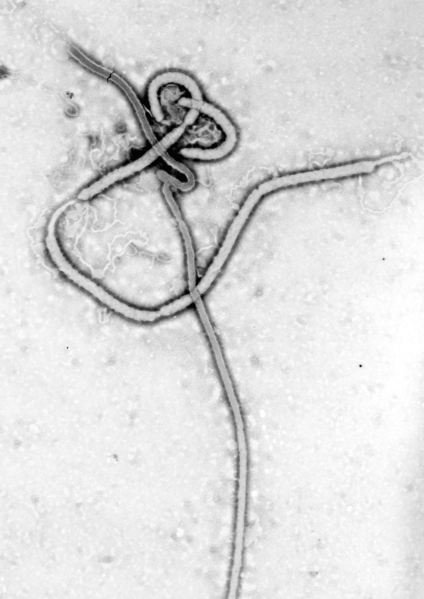Lêer:Ebola virus em.png

Grootte van hierdie voorskou: 424 × 599 piksels. Ander resolusies: 170 × 240 piksels | 340 × 480 piksels | 543 × 768 piksels | 724 × 1 024 piksels | 2 043 × 2 887 piksels.
Oorspronklike lêer (2 043 × 2 887 piksels, lêergrootte: 2,55 MG, MIME-tipe: image/png)
Lêergeskiedenis
Klik op die datum/tyd om te sien hoe die lêer destyds gelyk het.
| Datum/Tyd | Duimnaelskets | Dimensies | Gebruiker | Opmerking | |
|---|---|---|---|---|---|
| huidig | 09:33, 28 Julie 2014 |  | 2 043 × 2 887 (2,55 MG) | Splintercellguy | Upload higher-resolution version |
| 11:22, 24 Mei 2005 |  | 150 × 227 (19 KG) | Knutux | An electron micrograph of an Ebola viral particle showing the characteristic filamentous structure of a Filoviridae. The viral filaments can appear in images in various shapes including a 'u', '6', a coil, or branched resul |
Lêergebruik
Die volgende bladsy gebruik dié lêer:
Globale lêergebruik
Die volgende ander wiki's gebruik hierdie lêer:
- Gebruik in als.wikipedia.org
- Gebruik in ar.wikipedia.org
- Gebruik in arz.wikipedia.org
- Gebruik in ast.wikipedia.org
- Gebruik in bn.wikipedia.org
- Gebruik in ca.wikipedia.org
- Gebruik in ca.wikinews.org
- Gebruik in csb.wikipedia.org
- Gebruik in da.wikipedia.org
- Gebruik in de.wikipedia.org
- Gebruik in el.wikipedia.org
- Gebruik in en.wikipedia.org
- Wikipedia:Main Page/French
- Wikipedia:WikiProject Viruses/Templates
- Virus
- Wikipedia:Top 25 Report/July 27 to August 2, 2014
- Wikipedia:Top 25 Report/August 3 to 9, 2014
- RVSV-ZEBOV vaccine
- CAd3-ZEBOV
- 2016 in science
- Wikipedia:Top 25 Report/Records
- User:M1Abramstanbks/sandbox
- Wikipedia:In the news/Posted/May 2004
- Gebruik in en.wikinews.org
- Gebruik in eo.wikipedia.org
- Gebruik in eo.wikinews.org
- Gebruik in es.wikipedia.org
- Gebruik in et.wikipedia.org
- Gebruik in eu.wikipedia.org
- Gebruik in fi.wikiversity.org
- Gebruik in fr.wikipedia.org
- Gebruik in fr.wikibooks.org
- Gebruik in ga.wikipedia.org
- Gebruik in gl.wikipedia.org
Wys meer globale gebruik van die lêer.


